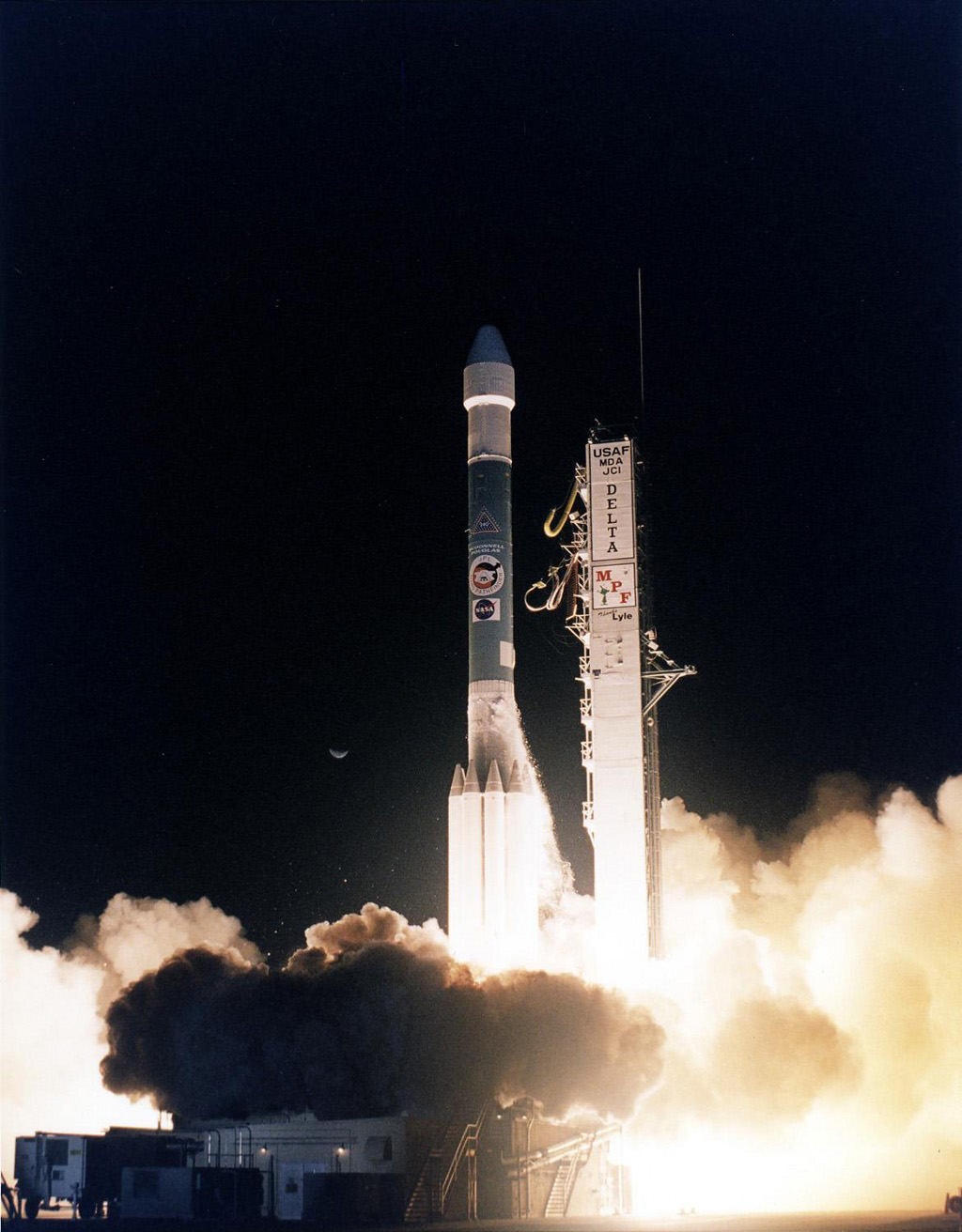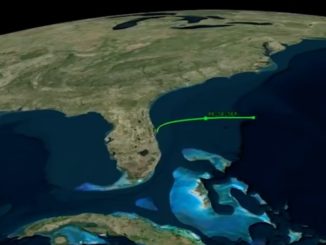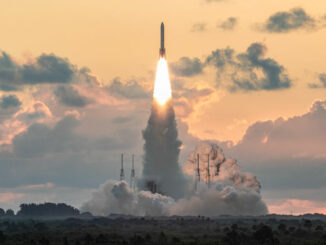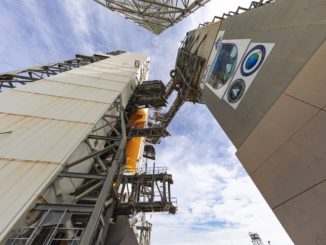
Update 3:10 p.m. ET: ULA flight teams called a scrub of the mission at about T-00:03:58.
United Launch Alliance will have to wait a bit longer before it bids a fond farewell to what its CEO calls “the most metal of all rockets.” Just seconds after the launch teams were coming out the final planned hold and into the final four minutes of the countdown, a hold was called and teams prepared to unload the propellant from the vehicle.
In a statement on social media, ULA President and CEO Tory Bruno explained the situation was a bit of a one, two punch.
“We exceeded the limit for winds and had to call a hold with a four-minute recycle,” Bruno said on X, formerly known as Twitter. “During the hold a Cape GN2 (gaseous nitrogen) pipeline ground pump failed causing a scrub. See you tomorrow.”
Liftoff from Space Launch Complex 37 (SLC-37) is now set for 1:37 p.m. EDT (1737 UTC). This mission, NROL-70, will be the last Delta rocket, flying in its three-core heavy configuration, on behalf of the National Reconnaissance Office (NRO). The rocket is carrying a classified payload and signals the end of the Delta chapter for ULA as its new Vulcan rocket prepares to really take over.
The 45th Weather Squadron forecasts only 30 percent odds of favorable weather for launch on Thursday, March 28, with ground winds and cumulus clouds being the primary concerns. Weather improves to 60 percent favorable on Friday with ground winds being the primary concern in this 24-hour backup scenario.
“Winds at ground level at the pad, especially on a Delta 4, which is a three-core rocket, lots of surface area, the concern is being blown back towards the launch tower,” said ULA President and CEO Tory Bruno during a prelaunch press conference. “We have a very well-understood criteria. It depends on the angle of the wind and we know what to do. We can launch through a pretty narrow moment in time. So, if the winds calm down, even for just a few minutes, so that we’re confident that that’s where they’re going to be, then we’ll launch through that opportunity.”
On Wednesday, ULA Launch Director Tom Heter III led the Launch Readiness Review (LRR), which resulted in leaders of ULA, the NRO and the U.S. Space Force signing off on the Launch Readiness Certificate.
Bruno marked the moment on Wednesday by remarking that the finale of Delta is “bittersweet” for him and the company.
“This is such and amazing piece of technology. 23 stories tall and half a million gallons of propellant, two-and-a-quarter million pounds of thrust and the most metal of all rockets, setting itself on fire before going to space,” Bruno said. “So, retiring it is obviously the future, moving to Vulcan, a less-expensive, higher-performance rocket, but still sad.”

The NROL-70 mission will mark the 12th time that the NRO has called upon the launch services of the Delta 4 Heavy rocket. The payload launching on this vehicle was awarded to ULA as part of a Launch Vehicle Production Services (LVPS) agreement on Oct. 24, 2018.
In September 2019, the Space and Missile Systems Center (now Space Systems Command) packaged it as part of a sole source, five-year, $1.18 billion Firm-Fixed-Price contract modification, which included Launch Operations Support (LOPS) for NROL-70 along with four other NRO missions. Officials said in a statement in 2019 that the bundle created a cost savings of $455 million.
“Mission success is our top priority. These satellites are critical to our Intelligence Community and national security,” said Col. Robert Bongiovi, Director of Launch Enterprise at the time. “Finalizing the launch operations support for these Delta IV Heavy launch services is a fundamental step to deliver these critical national assets to their intended orbits.”
“These are the last remnants of our sole source contracts. We look forward to embracing the competitive landscape that we have worked hard with industry to create,” he added. “The competitive launch services market is strong, and we look forward to the Phase 2 acquisition that leverages this market and builds upon our legacy of mission success.”
The Delta 4 rocket flew in the heavy configuration a total of 15 times leading up to its swan song:
- Dec. 21, 2004 – DemoSat
- Nov. 11, 2007 – DSP-23
- Jan. 18, 2009 – USA-202/NROL-26
- Nov. 21, 2010 – USA-223/NROL-32
- Jan. 20, 2011 – USA-224/NROL-49
- June 29, 2012 – USA-237/NROL-15
- Aug. 26, 2013 – USA-245/NROL-65
- Dec. 5, 2014 – NASA’s Orion Exploration Flight Test-1 (EFT-1)
- June 11, 2016 – USA-268/NROL-37
- Aug. 12, 2018 – NASA’s Parker Solar Probe
- Jan. 19, 2019 – NROL-71
- Dec. 11, 2020 – USA-268/NROL-44
- April 26, 2021 – NROL-82
- Sept. 24, 2022 – NROL-91 (final Vandenberg mission)
- June 22, 2023 – NROL-68
https://twitter.com/NatReconOfc/status/1664706195607769092
The Delta 4 Heavy flying the NROL-70 mission was delivered to the Cape in May 2023 after departing from the ULA’s factory in Decatur, Alabama, 22 years after the first Delta 4 (dubbed the ‘static fire test unit’) arrived for pathfinder testing.
The rocket is powered by a trio of common booster cores (CBSs), which are outfitted with RS-68A engines. The Delta Cryogenic Second Stage (DCSS) features an RL10C-2-1 engine and is topped with a metallic trisector payload fairing that harkens back to the aluminum isogrid fairings used on the Titan 4 from Martin Marietta (later Lockheed Martin).
Both stages use a combination of liquid oxygen and liquid hydrogen. In tandem, the three boosters produce 2.1 million pounds of thrust at liftoff. The upper stage generates 24,750 pounds of thrust following stage separation.
During a prelaunch media briefing, Brig. Gen. Kristin Panzenhagen, Space Launch Delta 45 Commander, noted that she has been part of the U.S. Air Force and subsequentially the U.S. Space Force since the Delta 4 Heavy began launching. She said she’s fortunate to have been in proximity to the rocket throughout its lifetime.
“Very exciting for me to be here. I was a young captain when we launched the first couple of Delta 4 Heavy’s out of here. So, to see that kind of come full circle is a special moment in my career,” Panzenhagen said.
She said it’s also illustrative of the partnerships needed to protect American interests in space and on the ground.
“The inter-agency partnership between the NRO and the Space Force, but then also, we wouldn’t be able to do this without our industry partners as well,” Panzenhagen said.
Dr. Chris Scalese, the director of the NRO, declined to go into detail about this national security spacecraft onboard the NROL-70 mission, but stated that it will bolster needed capabilities.
“It will provide exquisite capability that is needed by a lot of people and organizations, clearly, the policymakers, the warfighter and others, so that they can know what’s going on on the Earth,” Scalese said.

ULA’s Delta(-v)
Since its launch debut on May 13, 1960, as the Thor-Delta (aka Delta DM-19 or Delta), the Delta family of rockets showcased a storied history for civil and governmental spaceflight. Prior to the NROL-70 mission, Delta rockets have launched 388 times: 293 times from Cape Canaveral and 95 times from Vandenberg Space Force Base in California.
The lion’s share of the Delta legacy came from the teal-colored Delta 2 rocket. In the wake of the Challenger disaster, then President Ronald Regan issued a National Space Launch Strategy to develop a rocket designed for the military to have its launch capabilities. Delta 2 first flew on Feb. 14, 1989.
There were two variants of that vehicle, the lite 6000-series, which added the Extra Extended Long Tank first stage, and the 7000-series, which debuted GEM-40 solid boosters and the RS27A main engine.

The Delta 2 would go on to fly 155 mission in total, with eight of those being missions to Mars. NASA’s Spirit and Opportunity rovers got their ride to the Red Planet on a Delta 2 rocket.
Amid the myriad of Thor-Delta missions, versions of the rocket’s first stage were spunoff and built under license in Japan for that nation’s N-1, N-2 and H-1 vehicles, which launched from the Tanegashima Space Center a total of 24 times between 1975 and 1987.
In turn, that spun out the Delta 3 (8000-series), which was developed through a partnership between McDonnell Douglas and Boeing. However, it only flew three missions in total, two of which ended in failure and the third with just a dummy payload.
The sunsetting of that rocket made way for the Delta 4 rocket, which began launching in 2002. The vehicle boasted five different launch configurations:
- Delta 4 Medium
- Delta 4+(4,2)
- Delta 4+ (5,2)
- Delta 4+ (5,4)
- Delta 4 Heavy
The difference between the Delta 4+ rockets was if they flew a 4-meter or a 5-meter fairing and if they they had two or four strap-on solid rocket motors (SRMs). To date, there have been 45 launches of a Delta 4 rocket across all variations. The last Delta 4 Medium launched in August 2019.
Bruno said that while he previously was reluctant to answer questions about his favorite of the Delta 4 Heavy missions, he does have a clear preference: the 2018 launch of the Parker Solar Probe.
“And not just because it was a cool mission, where we were going to send a probe literally flying through the atmosphere of the Sun, currently the fastest human(-made) object in the universe, but also because we could have Dr. Parker there with us,” Bruno said. “90-years-old, a rebel scientist who first said space is not empty. It’s full of solar wind and things like that. And they told him he was crazy and he stuck to his guns. And eventually, we had the honor of flying the culmination of his life’s work.”
“So, up until this launch, that one was my favorite.”

Sunrise, sunset
This sunsetting of the Delta program comes as the sun rises on ULA’s next heavy-lift launch vehicle: Vulcan. The rocket performed its first certification mission (Cert-1) in January when it launched Astrobotic’s Peregrine lunar lander. It is now on its way towards launching Sierra Space’s Dream Chaser spacecraft to the International Space Station later this year.
Bruno said the NROL-70 mission that will culminate the Delta 4 Heavy line is a prime example of what Vulcan will be capable of launching using a single core, instead of three.
“The National Security Space mission is our core and the unique set of missions there require this high-energy rocket capability, very special orbits. And we designed Vulcan specifically for that. That’s its optimum,” Bruno said. “Every rocket can do a range of missions, but there’s one mission that it’s best at. [Vulcan] is literally designed to be best at the mission we’re going to fly here with this last Delta 4. So, that’s part of why it’s so important to us.”
“It collapses the price of that particular mission. Delta 4 is three rockets bolted together. That’s basically what it is. And with a single-core Vulcan, we’re able to collapse that cost by like 70 percent and make that mission a lot more practical and also able to fly at a much higher tempo, which is going to be pretty important as the country faces into the threat from Russia and especially China,” Bruno added.

Scolese said that even though this type of mission could be flown on a Vulcan in the future, logistics around timing made the final Delta 4 Heavy launch a more reasonable choice.
“It takes a lot of planning to put a payload on a rocket. So, we needed time to do it. And we had the spacecraft ready to go and we had a rocket that we trust. So, it made sense to continue on with this,” Scolese said. “Something has to be last and we’re proud to be that vehicle. We have a lot of confidence in the system: that’s the rocket, ULA, the Space Force, the Cape, everyone that’s involved in it.”
The higher tempo Bruno mentioned will be reflected in a launch cadence with Vulcan of between 25 and 30 times per year by the end of 2025. He said the pacing item in their supply chain are the Blue Origin-built BE-4 engines, the performance of which he lauded in the aftermath of Cert-1.
“The reason the BE-4 is a little bit behind everybody else is because it took a little longer to get it developed and finished and it is now,” Bruno said. “We have wonderful facilities in the BE-4 factory in Huntsville that Blue Origin has built and expanded, literally doubled their factory size to do this. So, they have to catch up now to everybody else building ahead.”
And while as they head of ULA Bruno said he’s looking forward to what comes next with Vulcan, he said it’s certainly the end of an era.
“It just has a storied legacy in our community and it has done great things for our nation,” Bruno said. “We’re very proud to have been a part of that. And even though Vulcan is the future, I’m personally sad to see it go.”



